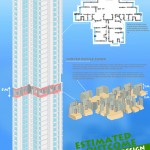Tseung Kwan O: LOHAS: Lifestyle of Health and Sustainability
Authors. CHENG Tin Chu Taylor, FONG Sum Wei, WONG Wing Sze Christine
Tseung Kwan O is one of the rapidly developing new towns in Hong Kong. There has been a lot of new construction, rapid growth in population and hence energy consumption in that area is quite high (especially for residential use). As Tseung Kwan O is still under development, renewable energy resources may be integrated inside new buildings and it may meet the local needs.
Wind and solar energy are two possible ways we are focusing upon, and our goal is to impart these two energy resources into a building. To do detailed research, about a particular place, LOHAS Park is our main focus because it is the largest residential development and it consists of the tallest residential buildings in the New Territories.
For wind energy, originally, we planned to build wind turbines on the roof and along mountains. Due to significant adverse visual impacts, our approach changed to install wind turbines within a building and hence we came up with an idea to make use of refuge floors. Vertical axis wind turbines are chosen since they occupy less space relative to horizontal axis type, so that more power can be generated. Concerning the refuge floor, we proposed to increase refuge floor heights to five meters and there are two concrete parts which are curved inside (to act as streamlined bodies), so as to increase the wind speed passing through turbines.
For solar energy, a glass-like material, building-integrated photovoltaics (BIPV) is used. Apart from placing them on the roof top, they can also be installed on each window. As a result, the building surface, which is exposed to sunlight could generate electricity as much as possible.
To conclude, a considerable amount of energy could be generated from wind and solar sources and it could approximately support over 80% of households in LOHAS Park and thus buildings in the future should be integrated with renewable resources, as it is beneficial to both residents and our environment.


